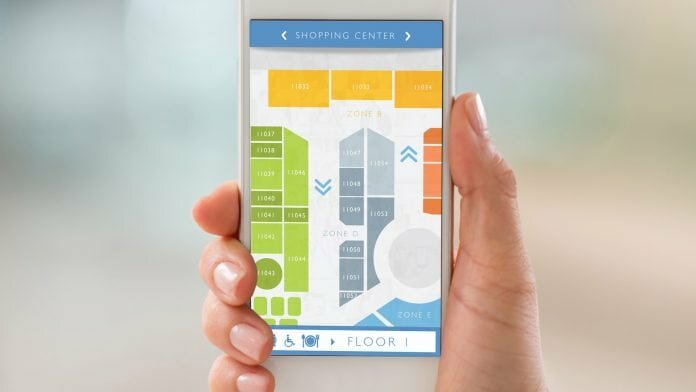
Galileo leverages its longtime expertise in GPS software receivers and simulators into the hot arena of indoor navigation and internet of things (IoT) location.
We all use outdoor positioning and navigation applications; whether we’re driving the car, hiking in the wild or flying an aeroplane. Endless numbers of industrial, agriculture, homeland security and other applications are using GPS satellites and low-cost mobile receivers for accurate real time positioning.
There is definitely a need for indoor navigation – we spend most of our time indoors, navigating buildings (e.g. hospitals, shopping malls, airports), underground (e.g. tunnels, mines), or even in dense urban places with limited satellite visibility.
Extending outdoor location-based services indoors will enable ubiquitous augmented reality, context-aware applications, allow for specialised promotions, coupons and tips. In some countries indoor positioning is a regulatory requirement enabling 911 and other emergency services.
However, indoor locations suffer technological barriers. GPS satellite signal is not currently received indoors, forcing technology companies to make workarounds by using alternative methods (e.g. BLE, WiFi) based on different end devices or by using a dedicated application for the end device. These workarounds increase cost, affect user experience, and make seamless outdoors-indoors navigation an issue.
Galileo Satellite Navigation solution
Galileo Satellite Navigation’s (GalNav) innovative solution is putting an end to the need for workarounds by extending the GPS coverage indoors. With GalNav’s solution, the existing end devices (e.g. smart phones) and applications can be used indoors in the same way they are used outdoors, with seamless handover and with no need for any hardware or software change.
About Galileo Satellite Navigation:
Galileo Satellite Navigation is an Israeli company for GNSS (Global Navigation Satellites Systems) development. GalNav specialises in comprehensive solutions for the challenging world of navigation. GalNav was founded in 2012 as a commercial company and since then has focused in developing its IP in three core technologies:
- GalNav SwRec: GNSS software receiver – Software define radio
- GalNav InDoor: GPS indoor navigation solution
- GalNav Simulator: GNSS simulator
GalNav InDoor: GPS indoor navigation solution
How does it work?
GPS (Global Satellite Navigation) is based on 24-32 satellites traveling above earth, each transmitting its location and accurate timing. A GPS receiver receives the signal from multiple visible satellites and, based on the signal differential and time of arrival received from four satellites or more, calculates its exact location.
The GalNav InDoor patented solution uses Micro GPS Simulators (MGSs) to simulate the GPS satellite system indoors. MGSs are installed on the ceiling or walls of the facility; each MGS simulating the signal of at least four GPS satellites that would have been received in this specific location if we were in an open sky environment with clear GPS satellite reception.
The MGSs transmitters are managed by a centralised GalNav controller, located in the facility. The GalNav controller is connected to an outdoor GPS receiver allowing it to synchronise to the GPS satellite’s signals – both timing and data.
The GalNav controller continuously analyses the GNSS open-sky picture and generates the simulated GPS signals for each of the local microsimulators based on its preconfigured position.
The user can seamlessly use any off-the-shelf GPS receiver (such as a smartphone) and any navigation application to navigate indoors just as you would to navigate outdoors.
Key Benefits:
Best user experience: GalNav InDoor is based on native navigation, therefore no new app needs to be installed and no advance registration is needed.
Works on existing devices: GalNav InDoor works on any device that has an integrated GNSS (the majority of smartphones).
Low up-front infrastructure installation cost: The buildings that provide indoor location are only required to install GalNav micro simulator end units and a distributed GPS synchronisation management controller.
Accuracy – down to 2m CEP – better than outdoor GPS navigation accuracy and better than most indoor alternatives.
Seamless, continuous outdoor-indoor transition – end device has no need to know if its outdoor or indoor, the same applications works seamlessly in both cases with smooth transition between outdoor and indoor navigation.
GalNav InDoor Use Cases:
Trade shows
Trade show organisers have an interest in letting visitors know where they are and where the company they want to visit is located. In large trade shows with thousands of people uploading pictures and trying to call each other, phone coverage is often weak and people cannot find each other. Indoor positioning would help them easily find their team members.
Supermarkets
Supermarkets can benefit from customers knowing where they are in the store, which isle they can find the products they are looking for and how to get there.
Hospital & public institutions
Visitors can find the patients they come to visit or find the destination for their treatment faster. Other benefits include: mobile medical equipment can be located quicker, staff can be relieved, hygiene rules controlled, itineraries analysed, appointments co-ordinated and costs reduced.
GalNav SwRec: software defined radio
GPS receivers are integrated into virtually any application, cell phones, cars, smart clocks, and IoTs. Using a software GPS receiver gives an advantage in every application in terms of price, flexibility and resource usage. Since the IoT market is the largest, the most price sensitive and has the ability to match the performance of the receiver to different needs, we will concentrate on it.
Galileo Internet of Things location solution
The IoT market is one of the fastest growing markets with 50 billion devices expected by 2020. While the initial aim of IoT devices was detecting and reporting data, it is becoming clear that IoT device positioning and timing is an important feature allowing tracking mobile end devices, and even by lowering the setup time of static devices and eliminating the logistical burden of linking the device and its position during installation.
However, adding hardware GPS receivers to IoT devices is not practical. The power consumption and cost that may be acceptable for high-end devices such as smartphones are not affordable for extremely low-end IoT devices.
GalNav was the first company to demonstrate a full GPS software receiver, working in real time and with a low-cost digital signal processor (DSP). The software receiver technology provides a full fixture and complete alternative to current hardware, GPS receivers and more.
GalNav SwRec software GPS receiver can run on the processor already available in most of the IoT devices. Implemented by software it allows very high flexibility for the IT software developer. It can be executed only upon need and the processing time (e.g. power consumption) can be adjusted according to the required accuracy.
Benefits
- Cost – Up to 90% cost reduction compared to competing hardware solutions.
- Accuracy – Can get down to 10cm accuracy level.
- Flexibility – Provide full control over all receiver blocks.
- Performance – Full customisation ability to support different use cases.
- Power – Very low power consumption.
- Size – No physical footprint.
GalNav GNSS simulator
With the booming market of location-aware devices, there comes a need for low cost test equipment to support development activity and end of line testing. GalNav developed a line of GNSS simulators that exactly fits the needs of small to large companies with the best return of investment for testing any location element installed in an IoT device, cellular phones and cars.
GalNav Simulator is a high-dynamic, flexible, Global Navigation Satellite Systems (GNSS) signal emulator that can be used for testing of any product that incorporates satellite navigation functionality. GalNav Simulator can be configured to emulate the satellite signals that will be visible to a GNSS receiver in any location in the world, at any time both past and future and along any trajectory, due to an extremely high update rate of every one millisecond.
Satellite constellation in a box
The flexibility and features of the GalNav GNSS Simulator make it ideal for product development, evaluation and testing environments. GalNav Simulator can emulate the signals from one or more satellite systems according to user licence.
The GalNav GNSS Simulator helps the user to evaluate the performance and characteristics of a GNSS receiver, including the following:
- Time To First Fix (TTFF) – specifies the amount of time required for a GNSS receiver to acquire satellite signals and navigation data and then to calculate a position solution (also called a fix).
- Acquisition sensitivity – specifies the minimum signal level (dBm) at which a GNSS receiver can successfully execute a cold start TTFF within a specified timeframe.
- Tracking sensitivity – specifies the minimum signal level (dBm) at which a specific GNSS receiver can successfully maintain a location fix within a specified degree of accuracy.
- Location accuracy – specifies the deviation between the positioning information that GalNav Simulator emulates and the receiver detects.
Eli Ariel
Founder and CEO
Galileo Satellite Navigation Ltd
+97239664499
[email protected]


















